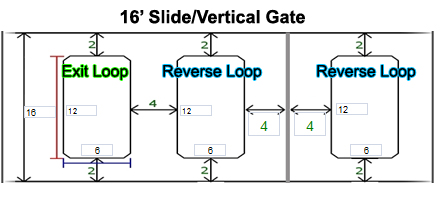Educational Articles
Explaining Loop Systems to Your Customers
It can be hard to explain to a customer how inductance loops work or why they are needed for gate systems. Inductance loops offer customers both convenience and peace of mind. If a customer is purchasing a brand new gate system having a reliable means of vehicle detection can help them enjoy the system even more. Educating your customers about the advantages of installing loops on their system will help you sell more loops and accessories.
How do Loops Work?
Loops work off of inductance, not magnetism. This is why they are sometimes referred to as inductance loops. Any material that is a good conductor of electricity (metal) can be detected by inductance loops. Detectors require a percentage of change to trigger a detection, which means that enough metal needs to enter the detection field to trigger a detection. Depending on how sensitive the system is an object as small as a metal trash can lid can trigger a detection.
Many installers and customers believe that loops work off of magnetism or pressure. Most magnetic materials contain iron and can be detected. Non magnetic materials such as aluminum and copper are excellent conductors of electricity and are also detectable objects.
As for pressure, customers who think that loops are air hoses or pressure plates that respond to weight will be confused when their horses or other heavy objects are not detected by the loops. It is important to give your customers a simple explanation of what loops detect, I often tell home owners that loops detect large metal objects such as cars and motorcycles.
How many loops does my system need?
This is one of the questions we are asked the most, the answer depends on the type of gate:
Slide Gate/Cantilever Gate/Vertical Lift/Vertical Pivot Gate: 2 Loops are required.
- Inside Reverse or Exit Loop
- Outside Reverse Loop

If space permits you may want to install an additional Exit Loop further down the driveway so that the gate will be open by the time the vehicle reaches the gate.
Swing Gate: 3 Loops are required.
- Inside Reverse or Exit Loop
- Shadow Loop underneath the gate swing path
- Outside Reverse Loop

If space permits you may want to install an additional Exit Loop further down the driveway so that the gate will be open by the time the vehicle reaches the gate.
What is the difference between a Reverse Loop and an Exit Loop?
Exit Loops automatically open the gate when a vehicle drives over them, they also will hold a gate open and reverse a closing gate which means they can used in place of an inside reverse loop.
A reverse loop will reverse a closing gate if a vehicle is detected. A reverse loop will also hold a gate open if a vehicle stops over the loop. If a gate is fully closed and a vehicle drives over a reverse loop nothing will happen, the gate will not open.
Features and Benefits of preformed loops:
Exit/Free Exit/Automatic Open Loops:
“Do you want to wait 15-30 seconds to leave your property every day?”
“We can install a loop that will automatically open the gate for you as you are exiting, no remotes required.”
“With an exit loop guests on your property will be able to leave without you having to follow them out to open the gate.”
For added convenience exit loops can be placed up the driveway 40-200’, so that the gate will be fully open by the time the car reaches the gate.
Shadow/Phantom/Center Loop:
Many installers don’t fully understand the function of this loop, which can make it hard to understand why it is so important on swing gates.
The Shadow Loop is placed under the swing path of a swing gate. This loop will check before the gate closes and/or opens to see if a vehicle is within the swing path, if a vehicle is within the swing path the gate will not move.
The shadow loop is very important, on a 12ft single swing gate there is 20ft of undetectable area between the inside and outside reverse loop that a car can easily fit into.
Not everyone looks at a gate to determine how it opens, guests and visitors can easily stop in a gates swing path while waiting to exit and without a shadow loop their car could be hit by the gate.
Reverse Loops:
Reverse loops hold the gate open or reverse a closing gate if a vehicle is detected. Reverse Loops offer customers peace of mind, and prevent panic and risky actions when a gate is closing.
These are common scenarios where reverse loops are important:
Vehicle tailgating/follow-through, without a reverse loop the gate could close on vehicles following another car through an open gate.
You’re exiting and find a child’s bike/skateboard/toy blocking your driveway exit, you get out of the car to move the bike and the gate starts closing on the vehicle.
A guest leaving their property inches up to the street waiting for an opening to pull out of the driveway, if they live on a street with high traffic, or where children play in the street you are not always able to exit quickly.
If you need additional assistance with loops please give us a call: 714-890-1604
BD Loops
The Loop Experts!
BD Loops was founded in 2001. Their preformed loops and accessories are designed with the installer in mind. BD Loops offers a complete loop system solution including preformed direct burial loops, preformed saw-cut loops, loop sealant, blades, testing devices, and installation tools. BD Loops has a reputation for reliability and ease of installation. They pride themselves on the quality of their products and their commitment to providing excellent customer service and support. BD Loops preformed loops are made in the USA at their facility in Placentia, CA.

